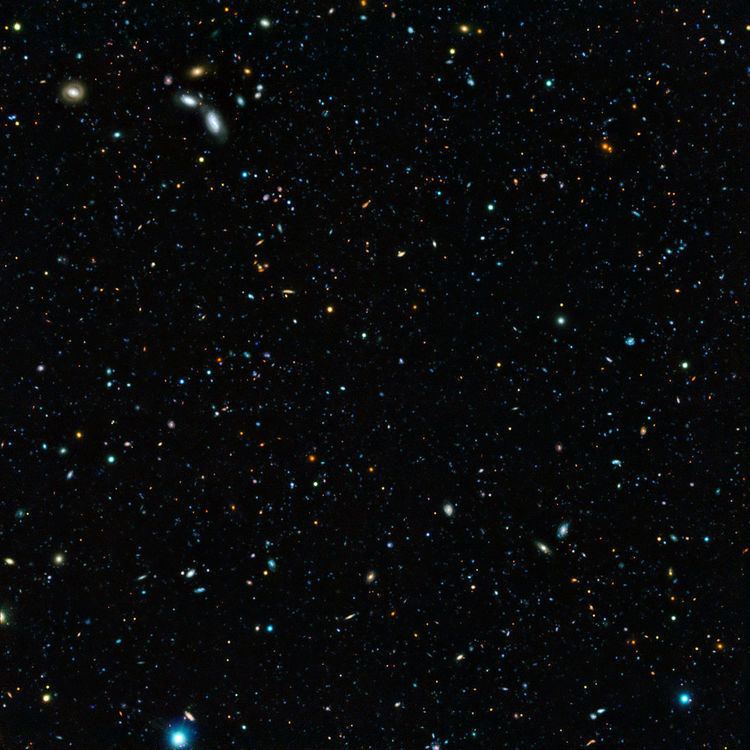An astronomical survey is a general map or image of a region of the sky which lacks a specific observational target. Alternatively, an astronomical survey may comprise a set of many images or spectra of objects which share a common type or feature. Surveys are often restricted to one band of the electromagnetic spectrum due to instrumental limitations, although multiwavelength surveys can be made by using multiple detectors, each sensitive to a different bandwidth. Surveys have generally been performed as part of the production of an astronomical catalog.
Sky surveys, unlike targeted observation of a specific object, allow astronomers to catalogue celestial objects and perform statistical analyses on them without making prohibitively lengthy observations. In some cases, an astronomer interested in a particular object will find that survey images are sufficient to make telescope time entirely unnecessary.
Surveys also help astronomers obtain observation time on larger, more powerful telescopes. If the astronomer can show a telescope scheduling committee that previous observations support his or her hypothesis, he or she is more likely to be given a chance to make more detailed observations.
The wide scope of surveys makes them ideal for astronomers searching for moving foreground objects such as asteroids and comets. An astronomer can compare existing survey images to current observations to locate targets which are in motion; this task can even be performed automatically using image analysis software. Similarly, images of the same object taken by different surveys can be compared to detect transient events such as variable stars.
OpticalPan-Andromeda Archaeological SurveyNational Geographic Society – Palomar Observatory Sky Survey (NGS–POSS) – survey of the northern sky on photographic plates, 1948–1958CfA Redshift Survey – A program from Harvard-Smithonian Center for Astrophysics. It began in 1977 to 1982 then from 1985 to 1995.Digitized Sky Survey – optical all-sky survey created from digitized photographic plates, 19942dF Galaxy Redshift Survey (2dfGRS) – redshift survey conducted by the Anglo-Australian Observatory between 1997 and 2002Sloan Digital Sky Survey (SDSS) – an optical and spectroscopic survey, 2000–2006 (first pass)Photopic Sky Survey – a survey with 37,440 individual exposures, 2010–2011.DEEP2 Redshift Survey (DEEP2) – Used Keck Telescopes to measure redshift of 50,000 galaxiesVIMOS-VLT Deep Survey (VVDS) – Franco-Italian study using the Very Large Telescope at Paranal ObservatoryPalomar Distant Solar System Survey (PDSSS)WiggleZ Dark Energy Survey (2006–2011) used the Australian Astronomical ObservatoryDark Energy Survey (DES) is a survey about one-tenth of the sky to find clues to the characteristics of dark energy.-Calar Alto Legacy Integral Field Area Survey (CALIFA) – a spectroscopic survey of galaxiesSAGES Legacy Unifying Globulars and GalaxieS (SAGES Legacy Unifying Globulars and GalaxieS Survey (SLUGGS) survey – a near-infrared spectro-photometric survey of 25 nearby early-type galaxies (2014)Large Sky Area Multi-Object Fiber Spectroscopic Telescope (LAMOST) – an extra-galactic and stellar spectroscopic surveyIPHAS and VPHAS+ – surveys of the Galactic bulge and inner disk using the Isaac Newton Telescope (north) and VLT Survey Telescope (south) in u, g, r, Hα, and i bands, 2003–presentInfraredInfrared Astronomical Satellite did an all sky survey at 12, 25, 60, and 100 μm, 1983The 2-micron All-Sky Survey (2MASS), a ground based all sky survey at J, H, and Ks bands (1.25, 1.65, and 2.17 μm) 1997–2001Akari (Astro-F) a Japanese mid and far infrared all-sky survey satellite, 2006–2008Wide-field Infrared Survey Explorer (WISE) was launched in December 2009 to begin a survey of 99% of the sky at wavelengths of 3.3, 4.7, 12, and 23 μm. The telescope is over a thousand times as sensitive as previous infrared surveys. The initial survey, consisting of each sky position imaged at least eight times, was completed by July 2010.UKIRT Infrared Deep Sky Survey (UKIDSS) – a collection of ground based northern hemisphere surveys (GPS, GCS, LAS, DXS, UDS) using the WFCAM camera on UKIRT, some wide and some very deep, in Z, Y, J, H, & K bands 2005–VISTA public surveys – a collection of ground based southern hemisphere surveys (VVV, VMC, VHS, VIKING, VIDEO, UltraVISTA), of various areas and depths, in Z, Y, J, H, & Ks bands, 2009–presentSCUBA-2 All Sky SurveyRadioHIPASS – Radio survey, the first blind HI survey to cover the entire southern sky. 1997–2002Ohio Sky Survey – Over 19,000 radio sources at 1415 MHz. 1965–1973.NVSS – Survey at 1.4 GHz mapping the sky north of −40 degFIRST – Survey to look for faint radio sources at twenty cms.PALFA Survey – On-going 1.4 GHz survey for radio pulsars using the Arecibo Observatory.GALEX Arecibo SDSS Survey GASS designed to measure the neutral hydrogen content of a representative sample of ~1000 massive, galaxiesC-BASS – On-going 5 GHz all sky survey to aid in the subtraction of galactic foregrounds from maps of the Cosmic Microwave BackgroundGamma-rayFermi Gamma-ray Space Telescope, formerly referred to as the "Gamma-ray Large Area Space Telescope (GLAST)." 2008–present; the goal for the telescope's lifetime is 10 years.Multi-wavelength surveysGAMA – the Galaxy And Mass Assembly survey combines data from a number of ground- and space-based observatories together with a large redshift survey, performed at the Anglo-Australian Telescope. The resulting dataset aims to be a comprehensive resource for studying the physics of the galaxy population and underlying mass structures in the recent universe.GOODS – The Great Observatories Origins Deep Survey.COSMOS – The Cosmic Evolution Survey(The latter two surveys are joining together observations obtained from space with the Hubble Space Telescope, the Spitzer Space Telescope, the Chandra X-ray Observatory and the XMM-Newton satellite, with a large set of observations obtained with ground-based telescopes).Atlas 3d Survey – sample of 260 galaxies for the Astrophysics project.PlannedPan-STARRS – a proposed 4-telescope large-field survey system to look for transient and variable sourcesLarge Synoptic Survey Telescope – a proposed very large telescope designed to repeatedly survey the whole sky that is visible from its locationASKAP HI All Sky Survey (WALLABY) – PI Bärbel KoribalskiThe Magellanic Clouds Photometric Survey – UBVI (optical)Deep Near Infrared Survey (DENIS) – near-IR
